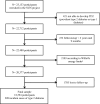Vitamin D and risk of developing type 2 diabetes in the SUN project: a prospective cohort study
- PMID: 38459212
- PMCID: PMC11368983
- DOI: 10.1007/s40618-024-02324-3
Vitamin D and risk of developing type 2 diabetes in the SUN project: a prospective cohort study
Abstract
Purpose: Vitamin D deficiency has been associated with multiple chronic diseases, including metabolic disorders such as insulin resistance and type 2 diabetes (T2D). The aim of the study was to analyze the association between validated predicted serum vitamin D status and the risk of developing T2D in a large prospective cohort based on a Mediterranean population.
Methods: The SUN project is a prospective and dynamic Spanish cohort that gathers university graduates who have answered lifestyle questionnaires, including a validated Food Frequency Questionnaire. The association between predicted serum vitamin D and the risk of T2D was assessed through Cox regression models according to quartiles (Q) of predicted vitamin D at baseline. The models were adjusted for potential confounders and sensitivity analyses were performed to ensure the robustness of our findings.
Results: Our study included a total of 18,594 participants and after a total follow-up of 238,078 person-years (median follow-up of 13.5 years), 209 individuals were diagnosed with incident T2D. We found a significant inverse association between predicted levels of serum vitamin D and the risk of developing T2D, after adjusting for potential confounders and performing different sensitivity analyses (hazard ratio Q4 vs. Q1: 0.48, 95% CI 0.26-0.88; p for trend = 0.032).
Conclusion: The outcomes suggest that higher levels of vitamin D at baseline may be associated with a reduced risk of developing T2D.
Keywords: Predicted vitamin D; Prospective cohort; SUN project; Type 2 diabetes.
© 2024. The Author(s).
Conflict of interest statement
The authors declare no conflict of interest. The funders had no role in the design of the study, collection, analysis and interpretation of the data; they did not intervene either in the writing process nor the decision to publish the outcomes.
Figures


Similar articles
-
Vitamin D and the Risk of Developing Hypertension in the SUN Project: A Prospective Cohort Study.Nutrients. 2024 Jul 20;16(14):2351. doi: 10.3390/nu16142351. Nutrients. 2024. PMID: 39064792 Free PMC article.
-
Predicted vitamin D levels and risk of depression in the SUN Project: A prospective cohort study.J Psychiatr Res. 2024 Nov;179:314-321. doi: 10.1016/j.jpsychires.2024.09.034. Epub 2024 Sep 24. J Psychiatr Res. 2024. PMID: 39353292
-
Association of vitamin D deficiency with incidence of type 2 diabetes in high-risk Asian subjects.Am J Clin Nutr. 2013 Mar;97(3):524-30. doi: 10.3945/ajcn.112.048496. Epub 2013 Jan 30. Am J Clin Nutr. 2013. PMID: 23364011 Free PMC article.
-
The relationship of vitamin D status to risk of cardiovascular disease and mortality.Dan Med J. 2015 Feb;62(2):B5008. Dan Med J. 2015. PMID: 25634511 Review.
-
Vitamin D Status, Calcium Intake and Risk of Developing Type 2 Diabetes: An Unresolved Issue.Nutrients. 2019 Mar 16;11(3):642. doi: 10.3390/nu11030642. Nutrients. 2019. PMID: 30884820 Free PMC article. Review.
Cited by
-
Vitamin D and COVID-19: comparative analysis with other respiratory infections and impact of comorbidities.Germs. 2024 Sep 30;14(3):232-245. doi: 10.18683/germs.2024.1435. eCollection 2024 Sep. Germs. 2024. PMID: 39776957 Free PMC article.
-
Effect of PM2.5 and its constituents on hospital admissions for cardiometabolic multimorbidity in Urumqi, China.Sci Rep. 2025 Feb 21;15(1):6394. doi: 10.1038/s41598-025-90789-4. Sci Rep. 2025. PMID: 39984684 Free PMC article.
-
Vitamin D and the Risk of Developing Hypertension in the SUN Project: A Prospective Cohort Study.Nutrients. 2024 Jul 20;16(14):2351. doi: 10.3390/nu16142351. Nutrients. 2024. PMID: 39064792 Free PMC article.
References
-
- Schleicher RL, Sternberg MR, Looker AC, Yetley EA, Lacher DA, Sempos CT et al (2016) National estimates of serum total 25-hydroxyvitamin D and metabolite concentrations measured by liquid chromatography-tandem mass spectrometry in the US population during 2007–2010. J Nutr 146(5):1051–1061 10.3945/jn.115.227728 - DOI - PMC - PubMed
MeSH terms
Substances
Grants and funding
- RD 06/0045/European Regional Development Fund
- PI10/02293/Ministerio de Ciencia e Innovación
- PI13/00615/Ministerio de Ciencia e Innovación
- PI14/01668/Ministerio de Ciencia e Innovación
- PI17/01795/Ministerio de Ciencia e Innovación
- PI20/00564/Ministerio de Ciencia e Innovación
- PI10/02658/Ministerio de Ciencia e Innovación
- PI14/01798/Ministerio de Ciencia e Innovación
- PI14/01764/Ministerio de Ciencia e Innovación
- G03/140/Ministerio de Ciencia e Innovación
- 27/2011/Gobierno de Navarra
- 45/2011/Gobierno de Navarra
- 122/2014/Gobierno de Navarra
- 2020/021/Plan Nacional sobre Drogas
LinkOut - more resources
Full Text Sources
Medical

